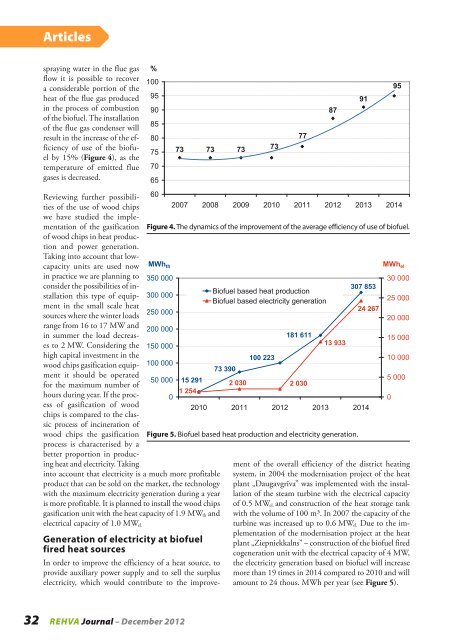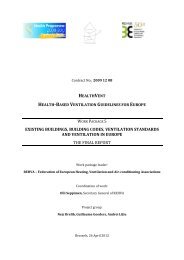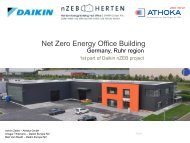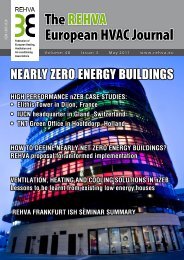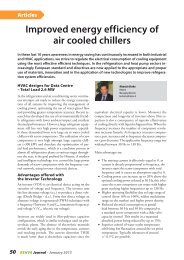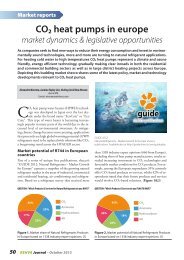Use of biofuels in the district heating system of Riga - rehva
Use of biofuels in the district heating system of Riga - rehva
Use of biofuels in the district heating system of Riga - rehva
You also want an ePaper? Increase the reach of your titles
YUMPU automatically turns print PDFs into web optimized ePapers that Google loves.
Articles<br />
spray<strong>in</strong>g water <strong>in</strong> <strong>the</strong> flue gas<br />
flow it is possible to recover<br />
a considerable portion <strong>of</strong> <strong>the</strong><br />
heat <strong>of</strong> <strong>the</strong> flue gas produced<br />
<strong>in</strong> <strong>the</strong> process <strong>of</strong> combustion<br />
<strong>of</strong> <strong>the</strong> bi<strong>of</strong>uel. The <strong>in</strong>stallation<br />
<strong>of</strong> <strong>the</strong> flue gas condenser will<br />
result <strong>in</strong> <strong>the</strong> <strong>in</strong>crease <strong>of</strong> <strong>the</strong> efficiency<br />
<strong>of</strong> use <strong>of</strong> <strong>the</strong> bi<strong>of</strong>uel<br />
by 15% (Figure 4), as <strong>the</strong><br />
temperature <strong>of</strong> emitted flue<br />
gases is decreased.<br />
100<br />
73 73 73<br />
Review<strong>in</strong>g fur<strong>the</strong>r possibilities<br />
<strong>of</strong> <strong>the</strong> use <strong>of</strong> wood chips<br />
60<br />
we have studied <strong>the</strong> implementation<br />
<strong>of</strong> <strong>the</strong> gasification<br />
<strong>of</strong> wood chips <strong>in</strong> heat production<br />
and power generation.<br />
Tak<strong>in</strong>g <strong>in</strong>to account that lowcapacity<br />
units are used now<br />
<strong>in</strong> practice we are plann<strong>in</strong>g to 350 000<br />
consider <strong>the</strong> possibilities <strong>of</strong> <strong>in</strong>stallation<br />
this type <strong>of</strong> equipment<br />
<strong>in</strong> <strong>the</strong> small scale heat<br />
300 000<br />
sources where <strong>the</strong> w<strong>in</strong>ter loads<br />
250 000<br />
range from 16 to 17 MW and<br />
200 000<br />
<strong>in</strong> summer <strong>the</strong> load decreases<br />
to 2 MW. Consider<strong>in</strong>g <strong>the</strong> 150 000<br />
high capital <strong>in</strong>vestment <strong>in</strong> <strong>the</strong><br />
wood chips gasification equipment<br />
it should be operated<br />
100 000<br />
50 000 15 291<br />
for <strong>the</strong> maximum number <strong>of</strong><br />
1 254<br />
hours dur<strong>in</strong>g year. If <strong>the</strong> process<br />
<strong>of</strong> gasification <strong>of</strong> wood<br />
0<br />
chips is compared to <strong>the</strong> classic<br />
process <strong>of</strong> <strong>in</strong>c<strong>in</strong>eration <strong>of</strong><br />
wood chips <strong>the</strong> gasification<br />
process is characterised by a<br />
better proportion <strong>in</strong> produc<strong>in</strong>g<br />
heat and electricity. Tak<strong>in</strong>g<br />
<strong>in</strong>to account that electricity is a much more pr<strong>of</strong>itable<br />
product that can be sold on <strong>the</strong> market, <strong>the</strong> technology<br />
with <strong>the</strong> maximum electricity generation dur<strong>in</strong>g a year<br />
is more pr<strong>of</strong>itable. It is planned to <strong>in</strong>stall <strong>the</strong> wood chips<br />
gasification unit with <strong>the</strong> heat capacity <strong>of</strong> 1.9 MW th and<br />
electrical capacity <strong>of</strong> 1.0 MW el.<br />
%<br />
95<br />
90<br />
85<br />
80<br />
75<br />
70<br />
65<br />
73<br />
2007 2008 2009 2010 2011 2012 2013 2014<br />
Figure 4. The dynamics <strong>of</strong> <strong>the</strong> improvement <strong>of</strong> <strong>the</strong> average efficiency <strong>of</strong> use <strong>of</strong> bi<strong>of</strong>uel.<br />
MWh th MWh el<br />
30 000<br />
307 853<br />
Bi<strong>of</strong>uel based heat production<br />
Bi<strong>of</strong>uel based electricity generation<br />
25 000<br />
24 267<br />
20 000<br />
181 611<br />
13 933<br />
15 000<br />
100 223<br />
10 000<br />
73 390<br />
2 030<br />
2 030<br />
5 000<br />
0<br />
2010 2011 2012 2013 2014<br />
Figure 5. Bi<strong>of</strong>uel based heat production and electricity generation.<br />
77<br />
Generation <strong>of</strong> electricity at bi<strong>of</strong>uel<br />
fired heat sources<br />
In order to improve <strong>the</strong> efficiency <strong>of</strong> a heat source, to<br />
provide auxiliary power supply and to sell <strong>the</strong> surplus<br />
electricity, which would contribute to <strong>the</strong> improvement<br />
<strong>of</strong> <strong>the</strong> overall efficiency <strong>of</strong> <strong>the</strong> <strong>district</strong> heat<strong>in</strong>g<br />
<strong>system</strong>, <strong>in</strong> 2004 <strong>the</strong> modernisation project <strong>of</strong> <strong>the</strong> heat<br />
plant „Daugavgrīva” was implemented with <strong>the</strong> <strong>in</strong>stallation<br />
<strong>of</strong> <strong>the</strong> steam turb<strong>in</strong>e with <strong>the</strong> electrical capacity<br />
<strong>of</strong> 0.5 MW el. and construction <strong>of</strong> <strong>the</strong> heat storage tank<br />
with <strong>the</strong> volume <strong>of</strong> 100 m³. In 2007 <strong>the</strong> capacity <strong>of</strong> <strong>the</strong><br />
turb<strong>in</strong>e was <strong>in</strong>creased up to 0.6 MW el. Due to <strong>the</strong> implementation<br />
<strong>of</strong> <strong>the</strong> modernisation project at <strong>the</strong> heat<br />
plant „Ziepniekkalns” – construction <strong>of</strong> <strong>the</strong> bi<strong>of</strong>uel fired<br />
cogeneration unit with <strong>the</strong> electrical capacity <strong>of</strong> 4 MW,<br />
<strong>the</strong> electricity generation based on bi<strong>of</strong>uel will <strong>in</strong>crease<br />
more than 19 times <strong>in</strong> 2014 compared to 2010 and will<br />
amount to 24 thous. MWh per year (see Figure 5).<br />
87<br />
91<br />
95<br />
32<br />
REHVA Journal – December 2012


